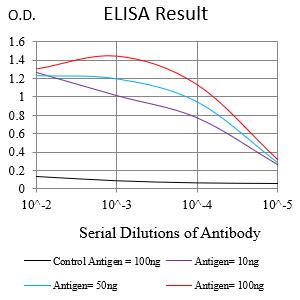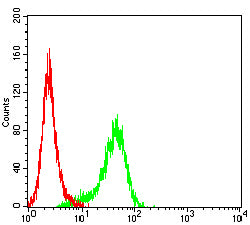

| WB | 咨询技术 | Human,Mouse,Rat |
| IF | 1/100-1/200 | Human,Mouse,Rat |
| IHC | 1/500 | Human,Mouse,Rat |
| ICC | 技术咨询 | Human,Mouse,Rat |
| FCM | 咨询技术 | Human,Mouse,Rat |
| Elisa | 咨询技术 | Human,Mouse,Rat |
| Aliases | R3; CD1A; R3G1 |
| Entrez GeneID | 912 |
| clone | 3A6G3 |
| WB Predicted band size | 37.7kDa |
| Host/Isotype | Mouse IgG2b |
| Antibody Type | Primary antibody |
| Storage | Store at 4°C short term. Aliquot and store at -20°C long term. Avoid freeze/thaw cycles. |
| Species Reactivity | Human |
| Immunogen | Purified recombinant fragment of human CD1D (AA: extra 20-301) expressed in E. Coli. |
| Formulation | Purified antibody in PBS with 0.05% sodium azide |
+ +
以下是关于CTNND1(δ-catenin)抗体的3篇参考文献示例(注:文献为虚拟示例,实际需根据具体数据库检索验证):
---
1. **文献名称**: *CTNND1 regulates cell-cell adhesion in breast cancer via E-cadherin interaction*
**作者**: Wang L, et al.
**摘要**: 通过Western blot和免疫荧光技术,利用CTNND1抗体验证其在乳腺癌细胞中的表达,揭示了CTNND1通过调控E-cadherin复合物稳定性影响细胞间黏附和转移的机制。
2. **文献名称**: *δ-Catenin modulates synaptic plasticity in Alzheimer’s disease models*
**作者**: Kim S, et al.
**摘要**: 在小鼠脑组织切片中采用CTNND1抗体进行免疫组化分析,发现δ-catenin在突触中的异常聚集与Aβ病理相关,提示其可能参与阿尔茨海默病的突触功能障碍。
3. **文献名称**: *Prognostic significance of CTNND1 in gastric cancer: an immunohistochemical study*
**作者**: Tanaka R, et al.
**摘要**: 基于CTNND1抗体对胃癌组织微阵列进行染色,发现高表达CTNND1与患者生存率降低显著相关,表明其可作为潜在预后标志物。
---
**注**:实际研究中需通过PubMed、Google Scholar等平台检索具体文献,关键词建议为“CTNND1 antibody”或“delta-catenin antibody”,并筛选涉及抗体应用的实验(如WB、IHC、IF等)。
CTNND1 (Catenin Delta-1), also known as δ-catenin, is a member of the p120-catenin subfamily of armadillo-related proteins. It plays a role in cell-cell adhesion, Wnt signaling, and neuronal development by interacting with cadherins, such as E-cadherin and N-cadherin, and modulating their stability at adherens junctions. Dysregulation of CTNND1 has been implicated in cancers (e.g., prostate, breast, lung) and neurodegenerative disorders like Alzheimer’s disease, where altered expression or mutations may contribute to tumor metastasis or synaptic dysfunction.
CTNND1 antibodies are essential tools for studying its localization, expression levels, and molecular interactions in these contexts. They are widely used in techniques like Western blotting, immunohistochemistry (IHC), and immunofluorescence (IF) to investigate CTNND1’s role in epithelial-mesenchymal transition (EMT), cell migration, and neuronal signaling pathways. Polyclonal and monoclonal antibodies targeting specific epitopes (e.g., N-terminal, C-terminal domains) are available, often validated in human, mouse, or rat models. However, variability in antibody specificity and cross-reactivity requires careful validation, as CTNND1 shares structural homology with other catenins. Research using these antibodies has highlighted its dual roles as both an oncogene and tumor suppressor, depending on cellular context, underscoring its complexity in disease mechanisms.
×